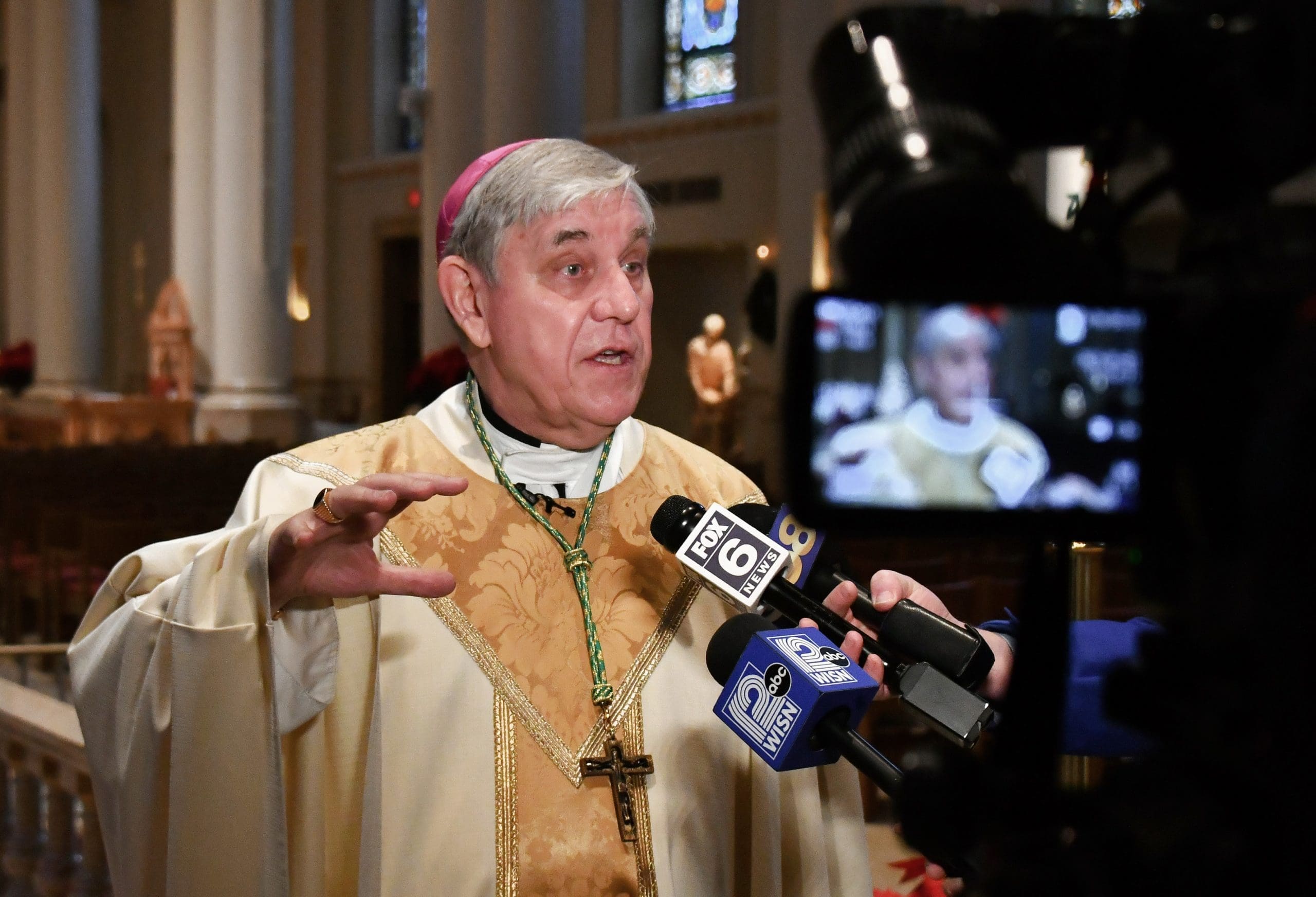
Archbishop Jerome E. Listecki on Jan. 1 discusses the impact of Pope Emeritus Benedict XVI, who as pope named him head of the Archdiocese of Milwaukee in 2010. (Photo by David Bernacchi)
Fr. Patrick Behling describes himself as a long-time admirer of Pope Emeritus Benedict XVI, so much so that he made the then-retired pope’s writings as Joseph Ratzinger the topic of his 2016 master’s thesis.
In his introduction, Fr. Behling said that he would not be a Christian, much less a priest, without Ratzinger’s many, many books and other writings.
“He showed me what it meant to be an intellectually sophisticated, historically conscious man of faith,” said Fr. Behling, associate pastor of St. Mary’s Visitation in Elm Grove. “I owe him a great deal for that.”
When he sent a copy of his thesis to the retired pope, Fr. Behling never expected a response, but Pope Benedict sent him one of his own books with a personal inscription.
“I miss him very much already,” Fr. Behling said.
Fr. Behling and other area priests shared their memories and reflections about Pope Benedict following his death Dec. 31 at age 95, nearly 10 years after becoming the first pope to retire from the papacy in nearly 600 years.
Though decades older than Fr. Behling, when he also was a seminarian, Bishop Jeffrey R. Haines became familiar with Benedict’s work as Ratzinger.
“I first met him in an intellectual manner in the classroom as I studied his influential theological impact behind the scenes of the Second Vatican Council,” Bishop Haines said. “Later, I was guided as priest and pastor by his role as prefect for the Congregation of the Doctrine of the Faith and as the pontiff as he sought to lead Catholics by a road map of the Council which balanced both continuity with Tradition and an evolutionary application of the faith to modern times.”
Pope Benedict had great local impact when he named Archbishop Jerome E. Listecki to lead the Archdiocese of Milwaukee in 2010.
“I wouldn’t be here in Milwaukee if it wasn’t for Pope Benedict. While I’m saddened by the news of his passing, I consider myself fortunate to have had several opportunities over the decades to meet him,” Archbishop Listecki said.
The first time Archbishop Listecki had met the Pope was in the early 2000s when he was Cardinal Joseph Ratzinger. Years later, as Archbishop, he received the Pallium from Pope Benedict in Rome. In 2012, Archbishop Listecki and hundreds of other U.S. bishops met with him during the USCCB’s Ad Limina visit to the Vatican.
Archbishop Listecki described Pope Benedict as “the greatest theologian of the century.”
“He was a great theologian. In his writings, he opened the understanding of the scriptures and was a tremendous advocate of objective truth. He was unafraid, like his predecessor St. John Paul II, to challenge the culture and the false sense of progressivism that is often cloaked in a sense of personal freedom.”
Fr. Jacob Strand, shared pastor of Holy Trinity and St. Michael parishes in Kewaskum, studied for the seminary in Rome from 2008 to 2013 — the last five years of Benedict’s pontificate.
“Undoubtedly, I learned more from his books than from any professors at my universities. It’s not an overstatement to say that he shaped my theological perspective more than anyone else,” Fr. Strand said.
Fr. Strand’s seminary was a 5-minute walk from St. Peter’s Basilica.
“We seminarians really felt like the pope was our local parish pastor,” he said. “Almost every Sunday, after Mass and brunch, we would walk to St. Peter’s Square to pray the Angelus with the pope, hear him comment on the Sunday Gospel, receive his blessing, and simply thank God that he was our pope.”
Fr. Jerry Herda, pastor of St. Matthias, Milwaukee, recalled being one of just 20 or so people to shake hands with Pope Benedict following a Papal Audience in 2007 attended by thousands.
“When I met him, which is an encounter for about 15 seconds, I introduced myself and said I would pray for him. I was struck by how short of a man he was,” said Fr. Herda, who is 6-foot-2, while published reports pegged the pope at 5-foot-7.
“While short in stature, he was one of the most intellectual and powerful men of his time,” Fr. Herda concluded.
In a Facebook post shortly after Benedict’s passing, Fr. Paul Hartmann said he had the honor of meeting Benedict when he was Cardinal Ratzinger and again as pope.
“Each time, he was genuinely interested in, and present to, whomever he greeted,” said Fr. Hartmann, a Milwaukee Archdiocesan priest who became associate general secretary of the U.S. Conference of Catholic Bishops last May.
Bishop James T. Schuerman recalled his surprise when Cardinal Ratzinger — who was well-known as a quiet, retiring theologian — was selected as pope to follow in the footsteps of the “larger than life personality” of now St. John Paul II.
Bishop Schuerman said he discovered Pope Benedict’s theological pursuits and defense of Church doctrine were grounded in a “very deeply spiritual individual” whose retirement was an act of humility.
Citing his age and diminishing energy, the then 85-year-old pope announced Feb. 11, 2013, that he would be resigning effective Feb. 28 and would devote the rest of his life to prayer.
MEMORIAL MASS
Everyone is welcome to attend a Memorial Mass for Pope Emeritus Benedict XVI to be celebrated by Archbishop Jerome E. Listecki at 5:15 p.m. Tuesday, Jan. 10, at the Cathedral of St. John the Evangelist. You are invited to attend to pray for the repose of his soul and in thanksgiving for his service to the Church.

This painting of Pope Emeritus Benedict XVI as pope will remain on display at the Cathedral of St. John the Evangelist until after a Memorial Mass is celebrated at 5:15 p.m. Tuesday, Jan. 10. (Photo by David Bernacchi)
